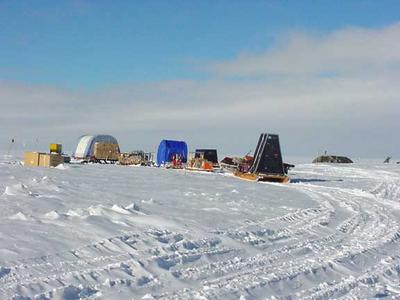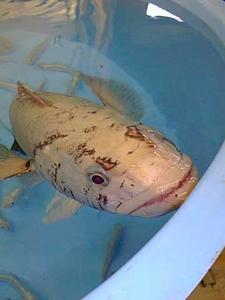22 November, 2002
Life at Byrd Surface Camp
Date: 11/22/02
Time: 1600 local time
Latitude: 80 degrees South
Longitude: 120 degrees West
Temperature: -16°C( 3°F)
Wind speed: 12 knots
Wind Chill: -26°C( -15°F)
Wind direction: Northeast
Meters of ice collected: 0
Notes on daily life:
Walking about in the foot-deep loose snow doesn't feel that different
here than it does anywhere after a big snowfall. Except for two things.
One, there is nothing but snow to see in all directions, other than a
few flags marking the runway, a few half-buried shelters, the old drill
tower where the Byrd ice core was drilled in the 1960s, and of course
the ITASE traverse equipment. Everything else is flat and white as far
as the eye can see. The other thing is when you stop and think about
it, there isn't just a foot of snow underfoot, which is what it feels
like! Imagine swimming in the Pacific Ocean, a thousand miles from
shore, with 10,000 or 20,000 feet of water underneath you. That’s about
the same scale we are experiencing: we are about 800 miles from "shore"
(McMurdo Station) and we are floating on top of about 10,000 feet of
snow and ice. To be exact, there are a few feet of snow, about 100
meters of old, compacted snow on the way to becoming glacier ice (this
is known as firn), and another 2000 meters of ice underneath us. Brian
told us this morning, after testing his radar system, which bounces
radio waves off the bedrock at the bottom of the ice sheet, that it was
2200 meters total from the surface to the bed. He measures the depth of
the ice by recording the amount of time a few fractions of a thousandth
of a second it takes the wave to leave his transmitter, bounce off the
bed, and return to his transmitter.
We found out yesterday that some bottles of chemicals (standards that
Markus needs for his experiments) got left behind in McMurdo. As
sometimes happens, this was lost in the shuffle of cargo in McMurdo,
after it was out of our hands. Today, a Twin Otter was sent out to
bring it to us. The Twin Otter is a Canadian-made plane that everyone
loves because they are wonderful to fly even in bad conditions; they
have a short takeoff and landing. Ken Borek Air, based in Alberta,
Canada, flies them all over the world and are here every year to work
for the National Science Foundation. It can be a bit costly forgetting
things; quite a lot of fuel and personnel time gets used up on a 1600
mile round trip flight, even in the efficient Twin Otter. It was a good
thing anyway, because our bicycle pump broke and this way we were able
to get a new one. What would we need a bicycle for? See if you can
guess from the photos on the web pages. We’ll let you know the answer
in a few days.
This afternoon we hooked up the trains. First, Lynn took the big
Challenger with the blade on the front and dug out the packed snow from
around the Blue Room and the Kitchen. Then we all dug in with shovels
to remove remaining ice and snow from the skis that these buildings sit
on top of. Then Karl hooked up the other Challenger to the Kitchen and
drove around in a big slow circle to get it in position. After that
came the fuel sled, which is really heavy and took a while to get
moving. To hook up the fuel sled behind the Kitchen, we crawled under
the Kitchen with a long cable which is attached to a winch on the
Challenger; the end of the cable was attached to the front of the fuel
sled. This allows us to pull the fuel sled up into position right
behind the Kitchen and hook it up. This all takes very careful
maneuvering by Karl and Lynn, who have the greatest amount of
experience with these heavy machines.
For dinner, we had tortillas with salsa, guacamole and just-caught
Antarctic cod, which marine biologist Art Devries gave us in McMurdo.
Art has been in Antarctica every year for more than two decades,
studying the unique antifreeze blood that allows these fish to live in
water below 2 degrees Celsius. Dinner conversation was a silly race to
come up with the names of every candy we could think of. We got to 152
before giving up. Here are a few examples: Three Musketeers, Candy
Hearts, Milky Way, Peeps….

Here we are lining the vehicles up. In front (behind the Challenger) is the kitchen. You can see the "skis" and the tow bar.

This is one of our Cats with a sledge that we will use to carry more fuel barrels. Even though we have fuel caches where we will pick up extra fuel, we have to carry all of our empties with us. So we are bringing an extra sledge to carry all of those barrels. Keep Antarctica Beautiful.

This is the tail end of one of the trains. The black triangular shaped thing is the "polar pooper" our outhouse.

We are nearly ready to go.

An Antarctic cod in an aquarium at McMurdo. (this photo was taken in 1999) These fish have blood that is a natural antifreeze. Scientists have been studying this species for many years.
Contact the TEA in the field at
.
If you cannot connect through your browser, copy the
TEA's e-mail address in the "To:" line of
your favorite e-mail package.
|
